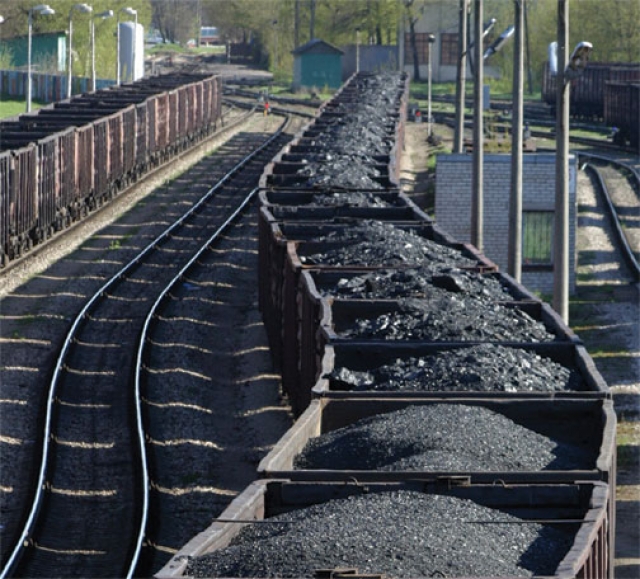
Sino-Mongolian Coal Relationship Continues Downward Spiral in 2013
Publication: China Brief Volume: 13 Issue: 17
By:

The Mongolian Minister of Mining, Davaajav Gankhuyag, meeting with journalists in an August 9 press conference, confirmed the continuing decline in coal exports to China, Mongolia’s most important trade partner: “The slow speed of economic growth of Mongolia is caused by a drop in China’s demand and the fall of coal prices by almost 40 percent.” The value of the first seven months of Mongolian unprocessed coal shipments to China declined nearly 50 percent to $582 million, versus $1.1 billion in 2012, as volume dropped by more than 20 percent, from 10 million metric tons in the same period in 2012 to only 8 million tons this year (The Mongol Messenger, August 16). In the first quarter of 2013, Mongolia’s GDP grew at an annual rate of 7.2 percent, as compared to 16.7 percent in the first quarter of 2012 (the country’s growth for all of 2012 was 12.3 percent). The World Bank has now lowered its prediction for Mongolia’s 2013 GDP growth from 16.2 percent to 13 percent. [1]
Although the World Bank and western financial analysts have attributed the drop in Mongolian coal exports to China’s cooling economy, which has depressed domestic coal demand and thus influenced prices on international coal markets (Stratfor, July 19), it is evident that the trade downturn is to some degree desired and manipulated by Mongolian policymakers, who are strongly influenced by overwhelmingly anti-Chinese domestic popular opinion. Mongolian policymakers believes that the overheated economic growth of the past few years was both unsustainable and dangerous. They sought to reduce coal exports, which make up the bulk of its exports to China, as a way to bring about greater economic stability. However, there is more to the story. Mongolia has been very anxious about the Chinese monopoly over its overall trade, mineral development and foreign direct investment (FDI). Centuries-long historical animosity between the two nations has spilled into the 21st century as a major factor in the way all Mongolians view their domestic economic development, as well as national security. The fact that Mongolia’s strong growth rate is directly tied to the fact that China is the nation’s number one trade partner and investor is not seen as a fortunate boon, but rather a slippery path coinciding with Chinese designs to overwhelm and eventually incorporate independent Mongolia into Chinese territory, along with southern, or Inner Mongolia. The Mongolian government appears to be reacting to concerns about the degree of its economic dependence on China—not, as it is sometimes simplistically labeled by western observers, a general antipathy to exporting natural resources, i.e. ‘resource nationalism’ or militant environmentalism. That the goal is diversifying markets, rather than limiting overall exports or foreign investment, is clear from the preferential treatment simultaneously accorded to South Korean and Japanese companies.
In April 2012, Mongolian authorities, motivated by inflamed anti-Chinese public rhetoric prior to parliamentary elections, intervened to stop the takeover by Chalco (Aluminum Corporation of China Ltd.) of a private Canadian-owned coal mine, Ovoot Tolgoi, which had been shipping all of its product to Chinese customers (“Mongolia’s Coal Development Policies Tied to Goal of Reducing Proportion of Chinese Investment,” Eurasia Daily Monitor, September 4, 2012). One month later, Chalco’s acquisition plan triggered an onerous tightening by Mongolia’s Parliament of foreign ownership investment regulations for the mineral sector, which were devised to stop foreign state-owned companies (e.g. Chalco and Chinese coal producer Shenhua) from investing in Mongolia (“The Bumpy Path to Sino-Mongolia Cooperation in the Mining Sector,” China Brief, February 1). Since then, virulent anti-Chinese sentiment, including attacks on Chinese workers, has been a major factor in Mongolian domestic politics for all political parties. China has not been able so far to respond with sufficient reassuring measures to calm these concerns.
Chalco, as the number one importer of Mongolian coal, also has run afoul of the Mongolian government’s exploitation of its 7.5 billion metric ton state-owned coal deposit in the Gobi called Tavan Tolgoi. The Tavan Tolgoi coal pricing agreement, in place since 2011, allowed Chalco to purchase raw coal excavated from the East Tsankhi tract at $70 a ton, which was considerably below the 2011 world price of about $100. In July 2011, the Chinese company paid U.S. $250 million in advance, but in January 2013 Mongolia stopped all Tavan Tolgoi coal deliveries to Chalco because the government claimed it had run out of funds and could not pay the private truck transport costs to the border, and so it demanded that the agreement be renegotiated. Since the Mongols had delivered only 2.5 million metric tons (worth US$170 million) of the 3 to 4 million tons promised, Chalco, strongly supported by Beijing authorities and the international mining community, threatened to take legal action.
With world coal prices collapsing, the Mongols were in a weak bargaining position. Shipments resumed in late April, after the Mongolian side agreed to pay a higher interest rate on missed deliveries and reduce fees for road transportation to the border. Chalco in turn agreed to pay $3 per metric ton more than the world price rate of $56 under an enlarged $350 million contract (Business-Mongolia.com, April 23). With the continued deterioration of world coal prices, the Mongols had to accept a lowered coal price of $47 per ton in July. Nevertheless, Deputy Minister of Mining Oyun Erdenebulgan promised to pay off the Chalco debt this year with delivery of an additional 3.6 million tons by increasing Tavan Tolgoi total output and reducing coal extraction costs (Ministry of Mining website cited in InfoMongolia.com, July 25 and The Mongol Messenger, August 16) Once this obligation is fulfilled, the Mongols will be able to diversify Tavan Tolgoi sales to other foreign partners.
The Mongolian Government also has implemented other initiatives to slow the pace of coal exports to China—sometimes under the mantle of environmental protection. For example, the Mongolian Ministry of Environment and Green Development on August 16 announced the closure of Tsagaan Khad, a coal customs stockyard on the Mongolian side of the border with China. It cited environmental damage from coal haulage, but there are reports that this measure has yet to be enforced (Platts, July 3).
Chairman of the Mongolian Coal Association board, Luvsandavaa Davaatsedev, in response to queries about the decline in shipments to China (in 2011, Mongolia was China’s largest supplier of coal, exporting 20 million metric tons), even as China increased its coal imports 40 percent since April 2012, has said: “Even if we don’t export our coal, China won’t be ruined and run out of coal, because there are so many competitors exporting coal to China. We placed second or third as China’s top coal exporter three years ago. But today, we aren’t even included in the top six. We’ve lost our position in this market because of trying to export coal at higher prices. Mongolia accounted for about 40 percent of China’s coal imports at our peak period. Now, we account for only 17 percent. It’s hard to take back our lost position.” (UB Post, August 6)
In addition to pressuring the Chinese for better prices for less coal product, the Mongolian Government for the past year has taken a number of steps to diversify its future Tavan Tolgoi coal customers, especially by wooing Japanese and South Korean investors . This trend has accelerated with the re-election of Mongolian President Tsakhia Elbegdorj in late June. In Tokyo it was reported that during early August meetings between the two governments on how to implement their Economic Partnership Agreement, Mongolia would give Japan privileges in the mining sector and establish “stable conditions to extract coal and copper” (“Japanese Prime Minister Abe Declares Mongolia’s Increasing Importance for Tokyo’s Foreign Policy,” Eurasia Daily Monitor, April 18; Nikkei, August 4). Mongolian media reported on ongoing negotiations to exempt Japanese private companies from high mineral export taxes and additional waivers of laws and regulations limiting investment in the financial and communications sector (InfoMongolia.com, August 8). It is expected that these special preferential conditions will be announced in September when Mongolia’s Prime Minister Norov Altankhuyag visits Japan.
Meanwhile, South Korean companies are now favored as international investors for construction in Mongolia’s transportation sector. Samsung was awarded a $483 million contract in early May to build the 267 kilometer railway from the Tavan Tolgoi coal field to the Chinese border. It is only one of the large Korean companies that are benefitting from Mongolia’s decision to expand Russian broad gauge rail lines throughout the country. This decision adds $3 to the cost of each metric ton of delivered coal, because the coal must be transferred to rail cars that are suitable for the smaller, internationally accepted, gauge used in China (News.mn English service, May 10). Kyeryong Group is involved in major construction projects for redevelopment of the capital city of Ulaanbaatar and will construct a 365 km highway between Ulaanbaatar and the northern border town Altanbulag, the site of a Mongolian-Russian free trade zone (UB Post, July 7). Once the domestic rail and road networks are in place, Mongolian minerals will have access to passage north through Russia to Pacific customers, expanding the reach of Mongolian exports beyond nearby Chinese buyers.
Mongolia knew that its actions against Chinese FDI in the coal sector, reduction of raw coal exports to China and revision of mining investment legislation would agitate foreign investors, but it may have not predicted the extent of the ramifications. These developments, accompanied by continuing problems over how to operate and develop the country’s large copper-gold deposit of Oyu Tolgoi (OT), which is controlled 66-34% by Rio Tinto/Turquoise Hill and the Mongolian government, have roiled the investment climate. According to figures released in mid-August by the Ministry of Economic Development, total FDI fell 43% in the first half of 2013 to US$961 billion, with geology, mining and petroleum FDI down by a third (Mongolian Daily Economic Update, August 18). Mining Minister Gankhuyag admitted that recent revisions to mining and investment legislation have caused doubts among investors because they were not properly researched and thought out: “Outside experts came to the conclusion that aside from unfavorable foreign influence, political actions and laws that were resolved for political reasons before the election facilitated to bring stability in the investment environment [put it] into a risk situation.” (The Mongol Messenger, August 16).
It is clear that Mongolian President Tsakia Elbegdorj is aware of the precarious economic situation his nation faces because of the fall-off in foreign investment, declining tax revenues and slowing growth. In August he convened a special meeting with present and past members of the National Security Council including former Presidents, Prime Ministers and major political party parliamentary chairmen, to gather a wide range of views. He then asked the national Parliament to interrupt its summer holiday to meet for a special weeklong session, starting September 2. The Parliament agreed to the special session to discuss proposals to change the controversial 2012 Strategic Enterprises Foreign Investment Law (Business-Mongolia.com, August 16). However, this parliamentary action should not be interpreted as leading to any major reversal of Mongolia’s brand of resource nationalist mineral policies. Rather, it is likely that the Elbegdorj administration’s efforts to reduce Chinese economic penetration and trade monopoly, while simultaneously expanding coal and other mineral exports to new Northeast Asian customers as well as finding new non–Chinese FDI partners, will be altered in degree but not in substance.
Notes:
1. Mongolia Economic Update, April 2013, World Bank < https://www.worldbank.org/content/dam/Worldbank/document/EAP/Mongolia/MQU_April_2013_en.pdf >.





